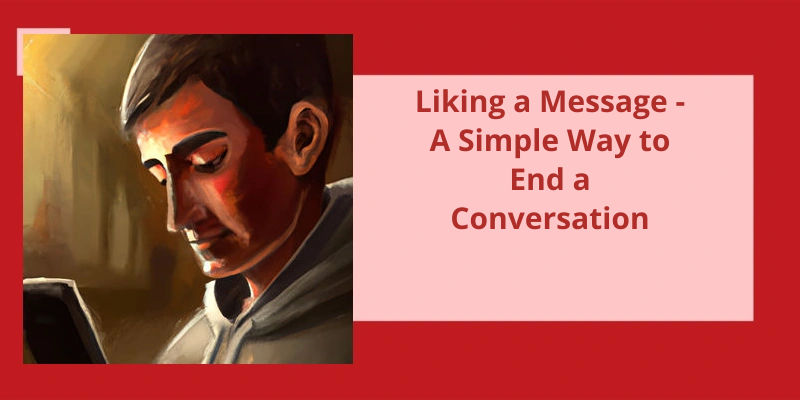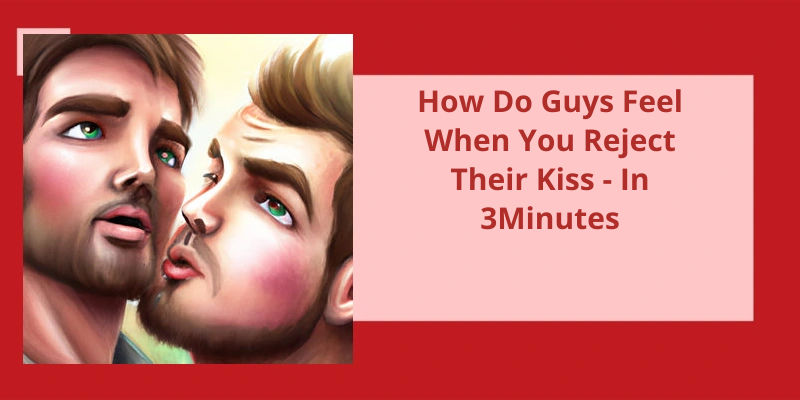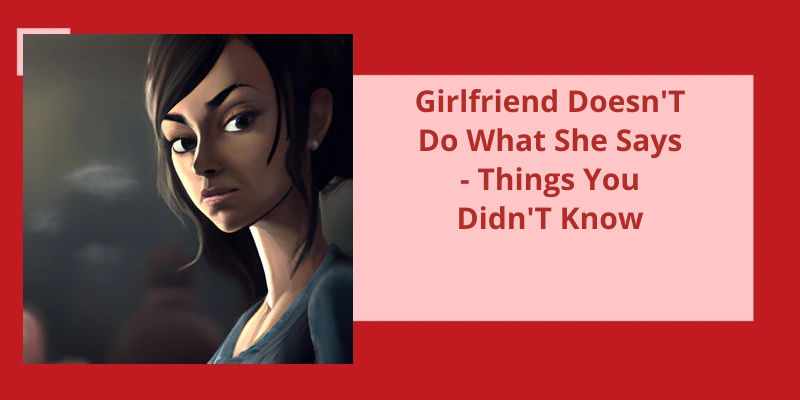As human beings, communication is an essential aspect of our social lives. We communicate with people for various reasons, such as exchanging information, expressing our feelings, or simply to socialize. However, at times, we find ourselves in situations where we want to end a conversation but don't know how to do so gracefully. One solution that’s become increasingly popular over the years is the act of liking a message to signify the end of communication. It may seem like a trivial gesture, but it’s an effective way to convey a message without being rude or abrupt. While some might view this as a new-age phenomenon, the act of liking a message to end a conversation has become a well-accepted form of etiquette in today's digital age.
What Does Someone Liking a Message Mean?
The act of liking a message is a simple but powerful way to communicate agreement, appreciation or support in a text conversation. This feature can be especially useful in group chats, where it can be hard for everyone to respond to every message in real time.
While a like may not carry as much weight as a thoughtful response or a longer conversation, it can still be a way for a user to show that they’re paying attention to the discussion. A like can also act as a reward or validation for the person who sent the message, as it shows that their words have resonated with the recipient. This kind of positive reinforcement can help to keep conversations flowing and encourage people to continue participating in the discussion.
Liking a message isnt always positive, however, and can also be a way to indicate disagreement, dislike, or a lack of interest. For example, if someone sends a message that’s offensive or inappropriate, a recipient might “like” it to acknowledge that they’ve seen it, while making it clear that they don’t approve of the content. In this case, a like can be a way to express disapproval without getting into a deeper conversation or escalating the argument.
As messaging apps continue to evolve and offer new features, the ability to like messages is likely to remain an important part of the conversation.
With our communication becoming increasingly digital, it can be difficult to express our emotions through text alone. Message reactions have emerged as a solution to this problem, allowing us to respond quickly and easily to individual messages with a variety of emotions. By utilizing message reactions, we can acknowledge and express our feelings in a lightweight and efficient manner, enhancing our communication in the digital realm.
What Does the Reaction Mean in Messages?
Message reactions have grown to become a significant part of our communication culture, especially amongst friends and colleagues. They allow us to express our emotions without having to type out a full response, and it’s a great way to let someone know that you”ve seen their message. Reacting to a message with a heart, for instance, signifies that you appreciate the message and the sender. When someone uses a reaction, it’s a sign that they’re engaged in the conversation, and they care about what’s being discussed.
It’s quicker than typing out a full reply and can be used to acknowledge the message without interrupting a meeting or other work functions. For instance, when discussing important matters in a Slack workspace, a quick thumbs-up or a checkmark on an important point means that the message has been seen and understood. Therefore, reactions have created system-wide efficiencies.
One of the best things about message reactions is that they help to prevent misunderstandings. It may be hard to discern tone and emoji messages can only do so much. It’s pretty common to misinterpret messages and experience communication breakdowns.
Responding to messages has become an essential part of our daily communication, and with the advent of various social media platforms and messaging apps, this task has become easier and more interesting. One such messaging app that offers a range of fun features to interact with text messages is iMessage. In this article, we will explore how to react to a liked message on iMessage and make your chats more exciting.
How Do You Respond to a Liked Message on iMessage?
Once you tap on the reaction, it will appear next to the message youre responding to, along with your name. This allows the person who sent the message to see that you’ve responded and what your reaction is. Additionally, if multiple people react to a message, all of their reactions will be visible to the sender.
Reacting to a message is a great way to quickly respond to a message without having to type out a full response. For example, if someone sends you a funny meme, you can quickly react with the laughing emoji instead of typing out “haha thats so funny.”
Overall, reacting to a liked message on iMessage is a simple and effective way to respond to a message without having to type out a long response. It allows you to quickly show your emotions and engage with the conversation in a fun and interactive way. So next time you receive a message you want to react to, simply tap and hold on the message and choose the reaction that best fits your response.
As we navigate the world of online communication, it’s important to understand the nuances between reactions and replies. While a like or other reaction may indicate our feelings about a message, it’s not the same as actively engaging with it. So, let’s explore this topic further and see how we can improve our online interactions.
Is Liking a Message Considered a Reply?
Liking a message doesn’t constitute a reply. The purpose of liking a message is to show that you saw it and to acknowledge that you appreciate it. A reply, on the other hand, requires more thought and consideration. It involves engaging with the content of the message and responding in a way that furthers the conversation. There’s a clear distinction between these two actions, and it’s important to understand the difference in order to effectively communicate with others.
While it’s a form of acknowledgement, it doesn’t provide any meaningful contribution to the conversation. Replies, on the other hand, are seen as more valuable because they demonstrate active engagement with the content being discussed. When we reply to a message, we provide our own perspective, ask questions, or offer support. This helps to build a sense of community and fosters deeper connections between individuals.
Reactions, such as emojis or thumbs up symbols, are often used in lieu of a reply. They’re a way to express a quick, uncomplicated response and can be useful in situations where a more in-depth reply isn’t necessary. However, it’s important to recognize that reactions aren’t replies and shouldn’t be used as a substitute for meaningful engagement. While they can be a fun and lighthearted way to show support, they should be used sparingly and with intention.
In order to effectively communicate with others, we need to learn to distinguish between messages that require acknowledgement and those that require a response. This means taking the time to read and understand the content of the message before deciding how to engage with it. If a message requires a reply, we should take the time to craft a thoughtful response that furthers the conversation and demonstrates our engagement with the topic at hand. Likewise, if a message only requires acknowledgement, we should use a like or simple reaction to show that we saw it without feeling the need to reply.
Ultimately, the key to successful communication in the digital age is to be intentional with our actions and messages. Liking a message can be a meaningful way to show support and acknowledgement, but it should never replace the value of a well-crafted reply. By understanding the distinction between a reaction and a reply, we can communicate more effectively and build stronger connections with those around us.
Source: A girl I’m really into liked my message but didn’t respond to …
Text messaging has become one of the most popular forms of communication in recent years. It allows people to connect with each other without the need for face-to-face interaction, making it perfect for those who prefer to communicate from the comfort of their own space. But what’s it about text messaging that makes it so appealing to people? Let’s explore some of the reasons why people like to communicate through text.
Why Do People Like Texts?
Texting allows us to have more control over the types of conversations we engage in, which can be especially beneficial in situations where we may feel uncomfortable or unsafe. For example, if we receive a call from someone we don’t want to talk to, we can simply ignore it and respond later by text if we choose. This gives us more autonomy when it comes to setting boundaries and choosing who we engage with.
Another reason people like texts is because they can be used to convey a wide range of emotions and feelings. With texting, we’ve access to a wide range of emojis and shorthand phrases that allow us to express ourselves in ways that arent always possible in face-to-face conversations. We can use exclamation points and emojis to convey excitement, or use ellipses and periods to convey a more serious tone. This flexibility allows us to tailor our messages to the situation at hand and convey our feelings more effectively.
Finally, texting can be a fun and playful way to interact with others. Whether were sending silly memes or engaging in witty banter, texting can be a lighthearted way to connect with people and show our sense of humor. By engaging in this type of communication, we can foster closer relationships with others and create a sense of community, even when were physically apart.
When it comes to texting your crush, timing is everything. You don’t want to come on too strong, but you also don’t want to wait so long that they lose interest. So, is it okay to message someone that you like them? In short, yes! Initiating a text conversation can show your crush that you’re interested, but there are a few things to keep in mind.
Is It OK to Message Someone That You Like Them?
When it comes to showing interest in someone, one of the most common ways these days is through texting. From a simple “hey” to a flirty message, sending a text to someone you like can be a great way to initiate a conversation. However, many people wonder if it’s okay to message someone that they like them. While there’s no clear answer to this question, it’s important to consider a few factors before making a move.
Initiating a text conversation with a crush can be scary, but it can also be exciting. It shows the person that youre interested in that youre not afraid to take the first step. At the same time, it’s important to remember that not everyone likes to be pursued aggressively, so it’s best to approach each situation with care. Starting a conversation with a casual “hey” can be a great way to gauge someones interest without coming on too strong.
The truth is, theres nothing wrong with seeming eager when it comes to sending a text message. It shows your crush that you really do like them and that youre not afraid to let them know. Being upfront and honest about your feelings can be a refreshing change of pace in a world where people often play games or hide their true intentions. Just be mindful not to overdo it, since texting too frequently or sending long, overly emotional messages can be off-putting.
Timing is also an important factor to consider when texting someone you like. If you wait too long to text them, they might think youre not that interested. It’s generally a good idea to follow up within the first 2 or 3 days after youve met or exchanged numbers. This shows that youre still interested and that youre not playing games. However, if youre texting someone who youve talked to for a while but havent seen in person, it’s okay to give a little more space between messages.
It’s also important to be respectful of the other persons time and schedule. If you know theyre busy, don’t bombard them with messages or expect them to respond right away. Similarly, if youre not able to text back right away, it’s okay to take your time and respond later. Just be sure to let them know why youre not able to respond right away, so they don’t think youre ignoring them.
If you feel like youre ready to take the plunge and let someone know how you feel, go for it! Just remember to be mindful of the other persons feelings and boundaries, and don’t be afraid to take things slow if thats what theyre comfortable with.
The Pros and Cons of Texting as a Form of Communication in Dating
- Pro: Texting allows for quick, convenient communication.
- Con: Texting can be misinterpreted or lacking in tone.
- Pro: Texting can be less intimidating than phone or in-person conversations.
- Con: Texting can lead to a lack of emotional connection and depth.
- Pro: Texting can facilitate communication throughout the day, keeping the relationship top of mind.
- Con: Texting can lead to over-reliance on digital communication and a lack of face-to-face interaction.
- Pro: Texting can be used to flirt and build attraction.
- Con: Texting can also lead to misunderstandings and mixed signals.
Conclusion
In conclusion, the act of liking a message to end a conversation is a small yet effective way of acknowledging the finality of a discussion. It demonstrates a level of respect for the other party's time and effort in communicating, while also providing closure to the interaction. While it may be viewed as informal or even impersonal by some, it can also be considered a polite and efficient method of communication. Ultimately, the choice to like a message or not should be based on the individuals and the context of the conversation. It should serve as a reminder that even in a world dominated by technology, the human element of communication and interpersonal connection remains crucial.






